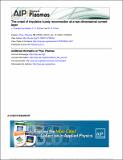Files in this item
The onset of impulsive bursty reconnection at a two-dimensional current layer
Item metadata
| dc.contributor.author | Fuentes-Fernández, J. | |
| dc.contributor.author | Parnell, Clare Elizabeth | |
| dc.contributor.author | Priest, Eric Ronald | |
| dc.date.accessioned | 2013-08-22T13:31:02Z | |
| dc.date.available | 2013-08-22T13:31:02Z | |
| dc.date.issued | 2012-05-09 | |
| dc.identifier | 66348187 | |
| dc.identifier | 45121bc4-36a9-455f-8284-9a54ad11c381 | |
| dc.identifier | 000307422800079 | |
| dc.identifier | 84866933211 | |
| dc.identifier.citation | Fuentes-Fernández , J , Parnell , C E & Priest , E R 2012 , ' The onset of impulsive bursty reconnection at a two-dimensional current layer ' , Physics of Plasmas , vol. 19 , no. 7 , 072901 . https://doi.org/10.1063/1.4729334 | en |
| dc.identifier.issn | 1070-664X | |
| dc.identifier.other | ArXiv: http://arxiv.org/abs/1205.2120v1 | |
| dc.identifier.other | ORCID: /0000-0002-5694-9069/work/73700705 | |
| dc.identifier.other | ORCID: /0000-0003-3621-6690/work/74117701 | |
| dc.identifier.uri | https://hdl.handle.net/10023/3977 | |
| dc.description.abstract | The sudden reconnection of a non-force free 2D current layer, embedded in a low-beta plasma, triggered by the onset of an anomalous resistivity, is studied in detail. The resulting behaviour consists of two main phases. Firstly, a transient reconnection phase, in which the current in the layer is rapidly dispersed and some flux is reconnected. This dispersal of current launches a family of small amplitude magnetic and plasma perturbations, which propagate away from the null at the local fast and slow magnetosonic speeds. The vast majority of the magnetic energy released in this phase goes into internal energy of the plasma, and only a tiny amount is converted into kinetic energy. In the wake of the outwards propagating pulses, an imbalance of Lorentz and pressure forces creates a stagnation flow which drives a regime of impulsive bursty reconnection, in which fast reconnection is turned on and off in a turbulent manner as the current density exceeds and falls below a critical value. During this phase, the null current density is continuously built up above a certain critical level, then dissipated very rapidly, and built up again, in a stochastic manner. Interestingly, the magnetic energy converted during this quasi-steady phase is greater than that converted during the initial transient reconnection phase. Again essentially all the energy converted during this phase goes directly to internal energy. These results are of potential importance for solar flares and coronal heating, and set a conceptually important reference for future 3D studies. | |
| dc.format.extent | 3140391 | |
| dc.language.iso | eng | |
| dc.relation.ispartof | Physics of Plasmas | en |
| dc.subject | Magnetic reconnection | en |
| dc.subject | Perturbation theory | en |
| dc.subject | Plasma kinetic theory | en |
| dc.subject | Stagnation flow | en |
| dc.title | The onset of impulsive bursty reconnection at a two-dimensional current layer | en |
| dc.type | Journal article | en |
| dc.contributor.institution | University of St Andrews. Applied Mathematics | en |
| dc.identifier.doi | 10.1063/1.4729334 | |
| dc.description.status | Peer reviewed | en |
This item appears in the following Collection(s)
Items in the St Andrews Research Repository are protected by copyright, with all rights reserved, unless otherwise indicated.

